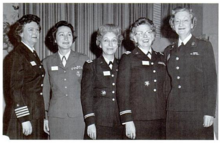Emily C. Gorman
Emily Carla Gorman | |
|---|---|
 From left to right: Viola B. Sanders, Elizabeth Ray, Emily C. Gorman, Mary E. Kelly, and Margaret M. Henderson after Kelly became the newly named deputy director of the Women's Army Corps on 3 January 1963. | |
| Born | April 9, 1909 New York |
| Died | July 4, 2005 (aged 96) St. Petersburg, Florida |
| Buried | |
| Allegiance | United States |
| Service/ | Army |
| Rank | Colonel |
| Unit | Director, Women's Army Corps |
| Awards | Army Distinguished Service Medal |
| Alma mater | Cornell University |
Colonel Emily C. Gorman (April 9, 1909 – July 4, 2005) was the sixth director of the United States Women's Army Corps (WAC) from 1962 to 1966. She was awarded the Distinguished Service Medal for her service during the Cold War.
Early life and education
Emily C. Gorman was born in New York on April 9, 1909. She was valedictorian of her graduating high school class in Pulaski, New York,[1] and she graduated from Cornell University in 1931.[1] At Cornell, she was a member of the Kappa Kappa Gamma sorority.[1] She worked as a teacher in New York until she enlisted in the Women's Army Corps in 1942.[1]
Gorman graduated from the Women's Army Corps Officer Candidate School in October 1942. After graduating, she was appointed as chief of the School's administration school. In 1944, Gorman was appointed as the staff director for the Women's Army Corps surgeon general in Washington, D.C.[2]
Military career
World War II and early career
In August 1945, Gorman was assigned to
Two years later, she was promoted to lieutenant colonel.
Women's Army Corps and Vietnam war

In May 1962, President Kennedy received Gorman and the former WAC directors at the White House to publicly celebrate the 20th Anniversary of the Women's Army Corps.[2]
Gorman was sworn in as WAC director and promoted to colonel on 1 August 1962 by new secretary of the Army, Cyrus R. Vance. In 1963, she chose Lt. Col. Mary E. Kelly as her deputy director.[2] Gorman enrolled the Women's Army Corps in an exhibit program to increase public awareness of the Corps' functions. The exhibit was unveiled at the Pentagon on May 14, 1963. Gorman had assigned Lt. Col. Mildred I. C. Bailey as the head of the exhibit's planning team. The exhibit, "The Women's Army Corps–Serving with Pride and Dignity," toured the country for six and a half years.[2]
In 1963, Gorman approved and enforced a new policy to increase the role of enlisted women in the U.S. Army.[2] The plan included special dispensations for female soldiers based on the demands of currently enlisted women.[2] These changes included increased security in living environments and designated living spaces accessible only by female personnel. Female personnel had also requested locks on the doors to their private dormitories, and Gorman's plan provided these.[2] Through the policy, female soldiers were also permitted to decorate and personalize some areas of their living space.[2] Between 1962 and 1966, reports showed that Gorman's policy had increased enlistment around 12%.[2]
Gorman continued to push for improvements in housing for female personnel throughout the 1960s. In 1963, she adjusted some of her policy's plans for all-female housing, stating that female soldiers in some cases could live in gender-specific wings of male dorms, although they were ideally to be provided female-only entrances.[2]
In 1964, Gorman selected American female soldiers to assist in the structuring of a Women's Armed Forces Corps in Vietnam.[2] These women were assigned to support female Vietnamese soldiers in training and supporting a new infrastructure following the departure of American forces from the country.[2]
In the last year of Gorman's career as director of the WAC, she pushed for military engineers to maximize living space in bathrooms, private bedrooms and kitchens for female personnel.[2] In 1966, the Women's Army Corps held a groundbreaking ceremony for its newly designed barracks, and Gorman refused to attend, believing the engineers had not made adequate changes.[2] Gorman retired from her position as director in July 1966.[3]
Post-military career
Upon her retirement, Gorman was awarded the
After retiring from the military, Gorman worked at the Office of Economic Opportunity, aiding the implementation of programs against poverty.
Colonel Gorman died in 2005[5] at age 96. She is buried at Pulaski Village Cemetery in Pulaski, New York.[6]
Personal life
In 1962, Gorman received the Kappa Kappa Gamma Alumnae Achievement Award. She was a member of the American Association of University Women, the Business and Professional Women's Foundation, the National Association of Women Deans and Counselors, Robert Edwards American Legion Post 358, Monday Historical Club and Northern Oswego County Ambulance.
References
- ^ a b c d e "Emily C. Gorman". Syracuse Post Standard. 11 July 2005. Retrieved 25 June 2015.
- ^ a b c d e f g h i j k l m n o p q r Morden, Bettie J. (1990). "The Women's Army Corps, 1945-1978". history.army.mil. Washington, D.C.: U.S. Army Center of Military History. Retrieved 2019-10-15.
- ^ "New Director For Women's Army Named". The Sarasota Journal. 24 June 1966. Retrieved 25 June 2015.
- ^ "Valor awards for Emily C. Gorman". Military Times. Retrieved 25 June 2015.
- ^ "In Memory Of..." (PDF). Army Women's Foundation, Inc. 2007. Retrieved 25 June 2015.
- ^ "Col Emily Carla Gorman". Find a Grave. Retrieved 15 October 2019.
![]() This article incorporates public domain material from websites or documents of the United States Army Center of Military History.
This article incorporates public domain material from websites or documents of the United States Army Center of Military History.
